Red Aglaonema: Chinese Evergreen Plants with Red or Pink Leaves
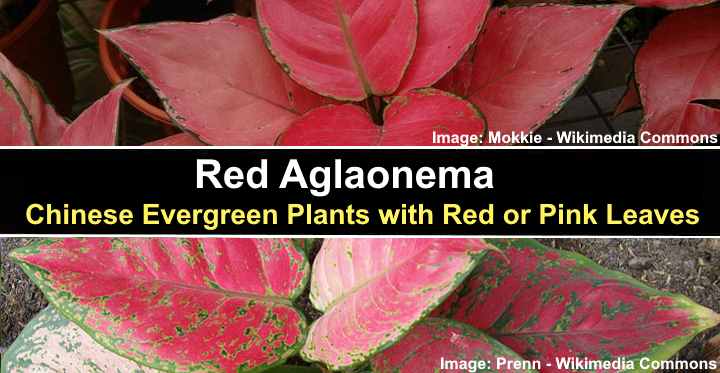
Red Aglaonemas are broadleaved tropical houseplants with large green, red, and sometimes pink leaves. Also called the Chinese evergreen plant, the red Aglaonema plants include cultivars of the flowering plant genus Aglaonema. Varieties of Aglaonema with pink and red leaves include ‘Siam Aglaonema,’ ‘Pink Dalmatian,’ ‘Ultra Pink,’ ‘Red Emerald,’ and ‘Super Red Star.’
Red Aglaonema plants are easy-to-care-for indoor plants. Their deep red leaves or light pink and green foliage look stunning in any interior. The medium-growth and tolerance of low light and drought mean that they are incredible hardy houseplants. Because there are many red Aglaonema varieties to choose from, there is a shade of pink or red to match most home interior décor.
This article is a guide to red Aglaonema plants. Along with descriptions of Aglaonema’s broad, pointed, colorful leafy foliage, pictures of red Aglaonemas will help you choose the perfect tropical indoor Aglaonema plant for your home.
About Red or Pink Aglaonema
Aglaonema plants with red or pink leaves are cultivars of the evergreen perennial genus Aglaonema. In the native habitat, species of Aglaonema grow in tropical and subtropical rainforests in Asia.
Colorful Aglaonema leaves are lance- or heart-shaped and grow between 4” and 12” (10 – 30 cm) long and between 2” and 4” (5 – 10 cm) wide. The simple leaves grow alternately on colorful stems.
There are many leaf pattern variations on red Aglaonema plants. Pink and red colors contrast with dark green glossy leaves. Some Aglaonema varieties have shiny green leaves with pink speckles. Other types of Aglaonemas have broad, dark green leaves with dark red veins. One of the most common red Aglaonema—the ‘Siam Aurora’—has olive green pointed leaves with pinkish-red margins.
If you keep red Aglaonema plants at home, it’s good to remember that they are poisonous. The ASPCA has Chinese evergreen on their list of plants toxic to dogs and cats. Ingesting parts of the plant can cause oral irritation, drooling, and difficulty swallowing.
Additionally, the sap from Aglaonema plants can cause dermatitis and skin irritation in humans. However, in typical circumstances, red Chinese evergreen plants don’t cause any serious issues if you handle them with care.
Some people keep red Aglaonema plants because it’s said that the plants bring good luck. In Feng Shui, the auspicious Chinese Evergreen is known as the Lucky Plant.
Another reason to keep Aglaonema plants is that some scientific research suggests that they are natural air purifiers. Scientists found that one Aglaonema species helped reduce levels of toxic chemicals such as toluene, xylene, benzene, and formaldehyde.
Red Aglaonema Care
To care for a red Aglaonema, grow the Chinese evergreen in low to medium, indirect sunlight. Plant a red Aglaonema in a loose, peat-based potting mix that has excellent drainage. Only water these Chinese evergreens when the soil is partially dry. Prune the red and pink foliage in spring to encourage bushy growth.
Red Aglaonema plants thrive outdoors in USDA zones 10 and 11. Growing indoors, Aglaonema plants prefer temperatures of at least 60°F (15.5°C) and humidity at least 60 percent. Generally, typical household conditions are ideal for growing red Aglaonema plants.
When growing a red Aglaonema at home, there are a few other things to remember. These tropical evergreens prefer even, warm temperatures. So, it’s good to keep them away from cold or hot drafts.
Although you can apply fertilizer once every so often, red Aglaonemas have a medium growth rate and can survive in rich, fertile soil without additional feeding.
Related reading: Aglaonema Care: How to Grow Chinese Evergreen.
Red Aglaonema (Chinese Evergreen) Flower

Aglaonema flowers
Red Aglaonema plants are flowering tropical plants that bloom in late summer. As with all arum plants in the family Araceae, Aglaonema produces spathe flowers. The Chinese evergreen flowers are made up of a whitish spadix and light green or colorful spathe. However, it’s rare for Aglaonemas to bloom indoors.
Many plant experts recommend cutting the Chinese evergreen flowers off if you notice them developing. This is said to help the plant concentrate all its energy in producing beautiful red, pink, and green leaves.
Red Aglaonema – Red or Pink Aglaonema with Colorful Leaves
Aglaonema plants come in many varieties. But many people say that the red and pink Aglaonema plants are the most spectacular. For example, the ‘Siam Aurora’ has lipstick-red patterns on bright green leaves. Or the ‘Red Majesty’—this plant has colorful red leaves with thin green margins. Other interesting Aglaonema varieties have pointed lime-green leaves with splashes of pink and white.
Types of Pink and Red Aglaonema (With Pictures)
Let’s look in more detail at some of the best red Aglaonema plants that you can grow at home.
Aglaonema ‘Siam Aurora’
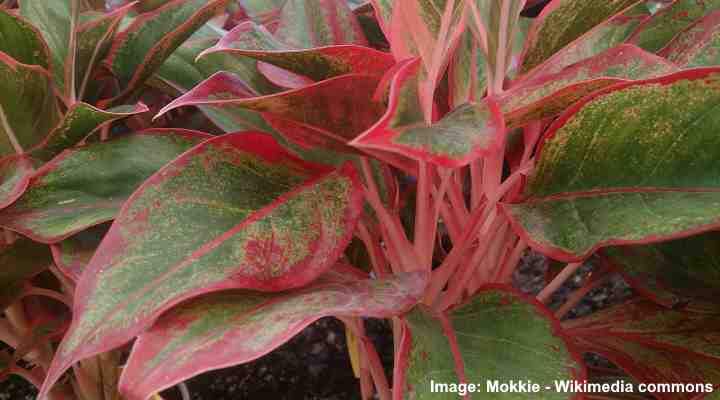
Aglaonema ‘Siam Aurora’
The Aglaonema ‘Siam Aurora’ is a stunning example of a red aglaonema plant with red and green leaves. The large, broadly lanceolate leaves are mostly green with deep red margins. You’ll also find some red ‘Siam Aurora’ plants with pinkish-red leaves and speckles of dark, olive-green patterns.
It’s best to care for the red Aglaonema ‘Siam Aurora’ by keeping it in medium, indirect light. Getting enough light helps keep the reds and pinks on the Chinese evergreen leaves vibrant. Although these plants survive in low-light, you may notice that their foliage loses its vibrancy.
When growing the red ‘Siam Aurora’ at home, a crucial thing to remember is to water it properly. As with all Aglaonema plants, the ‘Siam Aurora’ doesn’t like soggy potting soil. So, only water the tropical plant when the top layer of soil is dry.
‘Red Anjamani’ Aglaonema
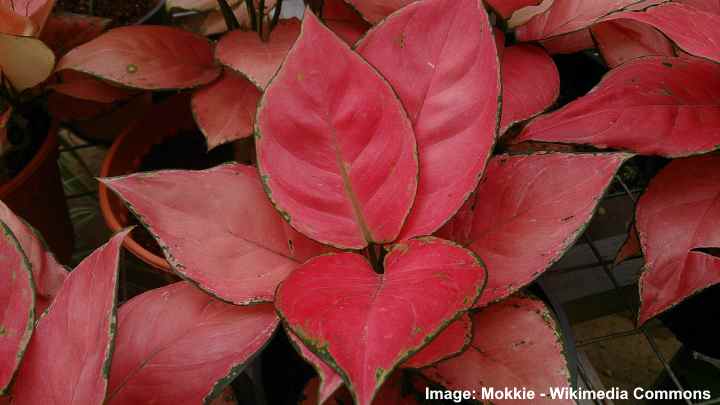
Aglaonema Red Anjamani
The Aglaonema ‘Red Anjamani’ has spectacular deep red heart-shaped or lance-shaped leaves with thin green margins. Looking at pictures of this red Aglaonema, you’ll notice faint green veins in the leaf blade. The bright red foliage and spotted dark green markings make this compact houseplant a popular choice.
One reason this red Aglaonema cultivar is so popular is that it keeps its vibrant colors throughout the year. The red leafy compact foliage looks stunning on a tabletop, bright windowsill, or office desk. The Aglaonema ‘Red Anjamani’ grows well in low light but may develop more green patterns on the red leaves.
Aglaonema ‘Lady Valentine’
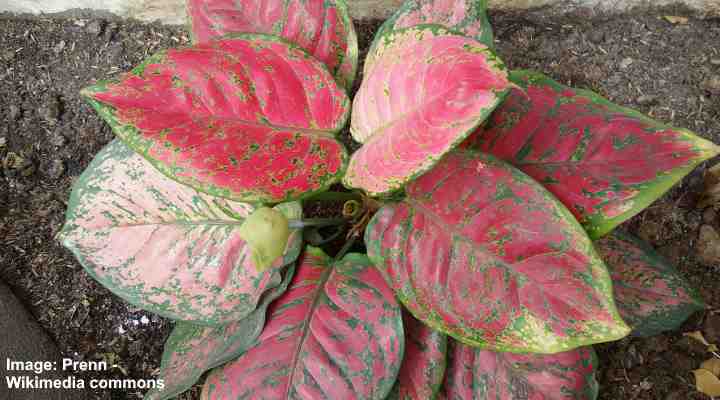
Aglaonema ‘Lady Valentine’
The red Aglaonema ‘Lady Valentine’ variety has oval to lanceolate red, pink, and green leaves. The fascinating Chinese evergreen leaves are mostly red and pink. The dark green markings appear along the blade edges and on the veins. The same Aglaonema can have pink and green leaves or bright red and lime green leaves on some plants.
Like many types of Aglaonema, the pink and red leaf coloration can depend on sunlight. It’s best to grow the plant in a relatively sunny location to bring out the pink and red hues. In low-light rooms, the leaves will become darker.
To help the red Aglaonema thrive, keep in even room temperatures between 60°F and 76°F (15.5°C – 24°C) and relatively high humidity.
Aglaonema ‘Two-Tone Moonstone’
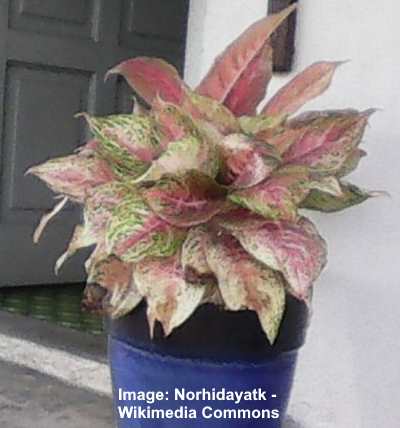
Aglaonema ‘Two-Tone Moonstone’
The ‘Two-Tone Moonstone’ Aglaonema is a colorful show stopping houseplant with light pink and light green leaves. The large, pointed leaves of this Chinese evergreen grow as a large clump of bright foliage. The beautiful green leaves have pink central ribs and masses of pink speckles.
Another exciting feature of the ‘Two-Tone Moonstone’ is the bright pink stems. This clean-air plant brightens up any room and adds visual appeal to a home’s décor.
Place the bushy pink and green Aglaonema in a sunny location for best results.
‘Super Red Star’ Aglaonema

Aglaonema ‘Super Red Star’
The Aglaonema ‘Super Red Star’ has spectacular bright red glossy leaves with only hints of green on the margins and tips. The exotic red foliage has a fantastic sheen that reflects natural or artificial light in a room.
A fascinating feature of the red Aglaonema leaves is that the variegation develops gradually. Some newer leaves may appear dark green with red blotches running down the midrib. As the red variegation develops, the whole plant’s leaf becomes bright red.
Thanks to the superb red coloring, this tropical cultivar can be called a true red Aglaonema.
Aglaonema ‘Super Pink’
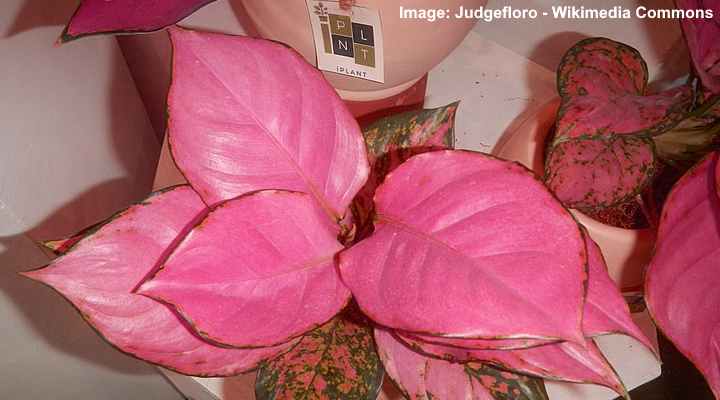
Aglaonema ‘Super Pink’
The tropical ‘Super Pink’ Aglaonema is another example of a stunning colorful houseplant. The leaves of ‘Super Pink’ Aglaonema are almost entirely pink. The pointed lance-shaped bright pink leaves may have some dark green dots or specks. However, some cultivars have pure pink leaves.
This rare pink houseplant’s compact growth makes it ideal for adding visual interest to complement modern décor. The potted pink Aglaonema plant looks stunning on a tabletop, desk, or bright windowsill.
Aglaonema ‘Pink Splash’

Aglaonema ‘pink splash’
The ‘Pink Splash’ Aglaonema is a compact, bushy Aglaonema plant with pink and green leaves. As its name suggests, this red Aglaonema cultivar has broad, glossy green pointed leaves with pink splashes. The level of pink variegation on the leaves depends on the cultivar and the amount of sunlight it gets.
The pink colors on the ‘Pink Splash’ Aglaonema range from pale pink, almost white coloration to dusty pink and dark pink.
The Aglaonema Chinese evergreen ‘Red Ruby’ plant looks like the ‘Pink Splash.’ The difference between the two cultivars is the vibrancy of the leaf color. The ‘Red Ruby’ has dark green leaves with bright red markings in contrast to light green and pink leaves.
‘Red Peacock’ Aglaonema
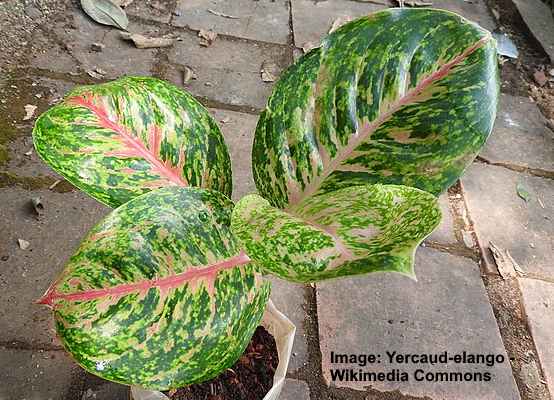
Aglaonema Red Peacock
The Aglaonema ‘Red Peacock’ has extraordinary broadleaves with green, pink, and yellow variegation. Compared to other varieties of red Aglaonema plants, this cultivar seems to have the broadest leaves. The colorful Aglaonema leaves have lime green with bright pink veining arching out from the central midrib. The brilliant foliage comes from the creamy-yellow speckles and splashes on the leaves.
For best red Aglaonema care, only water the tropical plant when the top 2” (5 cm) of potting soil is dry, keep the plant in humid condition, and temperatures between 65°F and 76° (15°C – 24°C).
Aglaonema ‘Golden Passion’
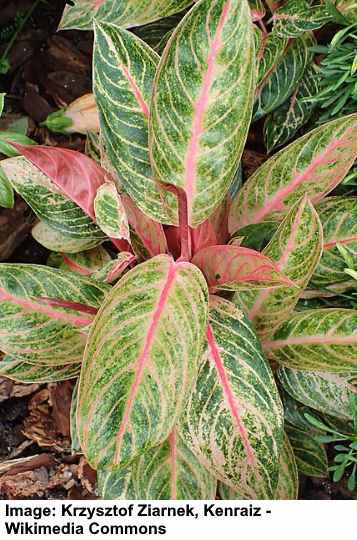
Aglaonema ‘Golden Passion’
The ‘Golden Passion’ Aglaonema has oblong-ovate light green leaves with pink midribs and veins and yellow variegation. These Aglaonema leaves have an overall yellowish-green look. However, the leaf undersides are mostly dark pink. Additionally, new leaf growth looks like a pink tube before the green, yellow, and pink leaf unfurls.
Like other types of pink Aglaonema plants, the ‘Golden Passion’ has brightly-colored pink stems.
Aglaonema ‘Sparkling Sarah’
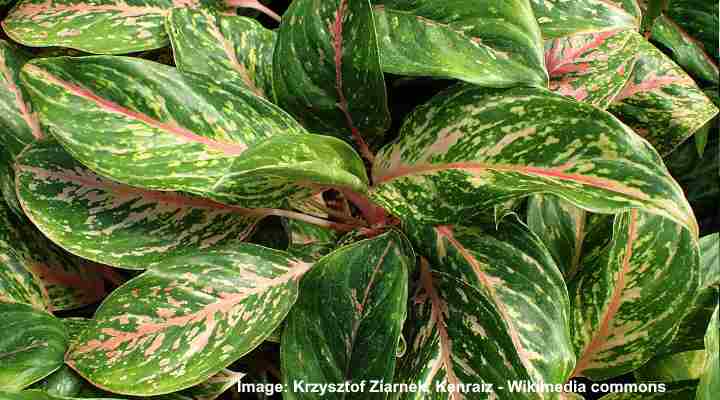
Aglaonema ‘Sparkling Sarah’
The exotic Aglaonema ‘Sparkling Sarah’ is a bushy plant with green, pink, and yellow variegation. The glossy lime green rounded ovate leaves have pink speckles decorating the midribs and veins. Depending on the amount of light this cultivar gets, the pink splashes could cover most of the green leaves.
A surprise feature of the ‘Sparkling Sarah’ is the bright pink veins. This beautiful pink pastel shade contrasts nicely with the yellow and green tropical leaves.
This easy-to-care-for houseplant grows well in lower light levels, making it ideal for homes and offices. To allow the ‘Sparkling Sarah’ cultivar to thrive, place in medium light, protected from direct sunlight, and only water the soil when it’s 50 percent dry.
Aglaonema ‘Emerald Holiday’
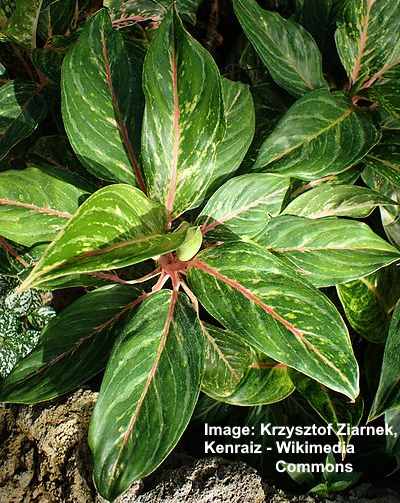
Aglaonema ‘Emerald Holiday’
The ‘Emerald Holiday’ Aglaonema plant has elongated lanceolate leaves with lush, shiny green leaves and dramatic red or pink veins. Although this Chinese evergreen’s overall color isn’t red, its pinkish-red stems and veins give the plant an unusual appearance.
Because the Aglaonema ‘Emerald Holiday’ has darker green leaves, it’s an ideal houseplant for darker rooms. The bush-like, clumping compact growth is perfect for growing in pots. Due to its love of humid, warm conditions, the ‘Emerald Holiday’ is a great bathroom plant.
Related articles:
- Red Leaf Houseplants (Including Plants with Red and Green Leaves)
- Colorful Indoor Plants: Colorful Leafy Plants (Red, Pink, Purple, White)
- Aglaonema Care: How to Grow Chinese Evergreen
